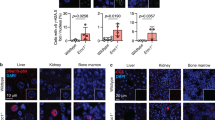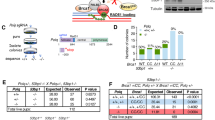Abstract
Accumulated evidence suggests that Parp-1 is involved in DNA repair processes, including base excision repair, single-strand and double-strand break repairs. To understand the precise role of Parp-1 in genomic stability in vivo, we carried out mutation analysis using Parp-1 knockout (Parp-1−/−) mice harboring two marker genes, gpt and red/gam genes. Spontaneous mutant frequencies of both genes in the bone marrows and livers did not differ significantly between Parp-1−/− and Parp-1+/+ mice (P>0.05). After treatment with an alkylating agent, N-nitrosobis(2-hydroxypropyl)amine (BHP), the mutant frequency of the red/gam genes in the liver in Parp-1−/− mice was 1.6-fold higher than that in Parp-1+/+ mice (P<0.05). Categorization of the mutations revealed that deletions larger than 1 kb or those accompanying 1–5 bp insertions at the deletion junctions, as well as rearrangements, were more frequently observed in Parp-1−/− than in Parp-1+/+ mice (P<0.05, respectively). In contrast, mutant frequencies of the gpt gene in the livers of Parp-1−/− and Parp-1+/+ mice after BHP treatment were both elevated and there was no significant difference between the genotypes. These results indicate that Parp-1 is implicated in suppressing deletion mutations in vivo, especially those accompanying small insertions or rearrangements.
This is a preview of subscription content, access via your institution
Access options
Subscribe to this journal
Receive 50 print issues and online access
$259.00 per year
only $5.18 per issue
Buy this article
- Purchase on Springer Link
- Instant access to full article PDF
Prices may be subject to local taxes which are calculated during checkout




Similar content being viewed by others
References
Adolph KW and Song MK . (1985). Biochemistry, 24, 345–352.
Ariumi Y, Masutani M, Copeland TD, Mimori T, Sugimura T, Shimotohno K, Ueda K, Hatanaka M and Noda M . (1999). Oncogene, 18, 4616–4625.
Bebenek K, Garcia-Diaz M, Blanco L and Kunkel TA . (2003). J. Biol. Chem., 278, 34685–34690.
Blaisdell JO and Wallace SS . (2001). Proc. Natl. Acad. Sci. USA, 98, 7426–7430.
Branch P, Aquilina G, Bignami M and Karran P . (1993). Nature, 362, 652–654.
Buki KG, Bauer PI, Hakam A and Kun E . (1995). J. Biol. Chem., 270, 3370–3377.
Caldecott KW, Aoufouchi S, Johnson P and Shall S . (1996a). Nucleic Acids Res., 24, 4387–4394.
Caldecott KW, Aoufouchi S, Johnson P and Shall S . (1996b). Nucleic Acids Res., 24, 4387–4394.
Dantzer F, de La Rubia G, Menissier-De Murcia J, Hostomsky Z, de Murcia G and Schreiber V . (2000). Biochemistry, 39, 7559–7569.
de Murcia JM, Niedergang C, Trucco C, Ricoul M, Dutrillaux B, Mark M, Oliver FJ, Masson M, Dierich A, LeMeur M, Walztinger C, Chambon P and de Murcia G . (1997). Proc. Natl. Acad. Sci. USA, 94, 7303–7307.
Ding Q, Reddy YV, Wang W, Woods T, Douglas P, Ramsden DA, Lees-Miller SP and Meek K . (2003). Mol. Cell. Biol., 23, 5836–5848.
Doll R . (1962). Gerontol. Clin. (Basel), 4, 211–221.
El-Khamisy SF, Masutani M, Suzuki H and Caldecott KW . (2003). Nucleic Acids Res., 31, 5526–5533.
Galande S and Kohwi-Shigematsu T . (1999). J. Biol. Chem., 274, 20521–20528.
Garcia-Diaz M, Bebenek K, Sabariegos R, Dominguez O, Rodriguez J, Kirchhoff T, Garcia-Palomero E, Picher AJ, Juarez R, Ruiz JF, Kunkel TA and Blanco L . (2002). J. Biol. Chem., 277, 13184–13191.
Green U, Konishi Y, Ketkar MB and Althoff J . (1980). Cancer Lett., 9, 257–261.
Harrison L, Hatahet Z and Wallace SS . (1999). J. Mol. Biol., 290, 667–684.
Kokkinakis DM . (1992). Carcinogenesis, 13, 759–765.
Leppard JB, Dong Z, Mackey ZB and Tomkinson AE . (2003). Mol. Cell. Biol., 23, 5919–5927.
Li B, Navarro S, Kasahara N and Comai L . (2004). J. Biol. Chem., 279, 13659–13667.
Lieber MR, Ma Y, Pannicke U and Schwarz K . (2003). Nat. Rev. Mol. Cell Biol., 4, 712–720.
Masson M, Niedergang C, Schreiber V, Muller S, Menissier-de Murcia J and de Murcia G . (1998). Mol. Cell. Biol., 18, 3563–3571.
Masumura K, Kuniya K, Kurobe T, Fukuoka M, Yatagai F and Nohmi T . (2002). Environ. Mol. Mutagen., 40, 207–215.
Masumura K, Matsui M, Katoh M, Horiya N, Ueda O, Tanabe H, Yamada M, Suzuki H, Sofuni T and Nohmi T . (1999). Environ. Mol. Mutagen., 34, 1–8.
Masutani M, Nozaki T, Nakamoto K, Nakagama H, Suzuki H, Kusuoka O, Tsutsumi M and Sugimura T . (2000). Mutat. Res., 462, 159–166.
Masutani M, Suzuki H, Kamada N, Watanabe M, Ueda O, Nozaki T, Jishage K, Watanabe T, Sugimoto T, Nakagama H, Ochiya T and Sugimura T . (1999). Proc. Natl. Acad. Sci. USA, 96, 2301–2304.
Menissier-de Murcia J, Molinete M, Gradwohl G, Simonin F and de Murcia G . (1989). J. Mol. Biol., 210, 229–233.
Morrison C, Smith GC, Stingl L, Jackson SP, Wagner EF and Wang ZQ . (1997). Nat. Genet., 17, 479–482.
Nivard MJ, Czene K, Segerback D and Vogel EW . (2003). Mutat. Res., 529, 95–107.
Nohmi T, Katoh M, Suzuki H, Matsui M, Yamada M, Watanabe M, Suzuki M, Horiya N, Ueda O, Shibuya T, Ikeda H and Sofuni T . (1996). Environ. Mol. Mutagen., 28, 465–470.
Nohmi T and Masumura K . (2004). Adv. Biophys., 38, 97–121.
Nohmi T, Suzuki M, Masumura K, Yamada M, Matsui K, Ueda O, Suzuki H, Katoh M, Ikeda H and Sofuni T . (1999). Environ. Mol. Mutagen., 34, 9–15.
Nozaki T, Fujihara H, Watanabe M, Tsutsumi M, Nakamoto K, Kusuoka O, Kamada N, Suzuki H, Nakagama H, Sugimura T and Masutani M . (2003). Cancer Sci., 94, 497–500.
Oikawa A, Tohda H, Kanai M, Miwa M and Sugimura T . (1980). Biochem. Biophys. Res. Commun., 97, 1311–1316.
Okada N, Masumura K, Nohmi T and Yajima N . (1999). Environ. Mol. Mutagen., 34, 106–111.
Okano S, Lan L, Caldecott KW, Mori T and Yasui A . (2003). Mol. Cell. Biol., 23, 3974–3981.
Oshima J, Huang S, Pae C, Campisi J and Schiestl RH . (2002). Cancer Res., 62, 547–551.
Paull TT and Gellert M . (2000). Proc. Natl. Acad. Sci. USA, 97, 6409–6414.
Prasad R, Lavrik OI, Kim SJ, Kedar P, Yang XP, Vande Berg BJ and Wilson SH . (2001). J. Biol. Chem., 276, 32411–32414.
Roth DB and Wilson JH . (1986). Mol. Cell. Biol., 6, 4295–4304.
Sanderson RJ and Lindahl T . (2002). DNA Repair (Amst.), 1, 547–558.
Sasaki S, Kitagawa Y, Sekido Y, Minna JD, Kuwano H, Yokota J and Kohno T . (2003). Oncogene, 22, 3792–3798.
Schreiber V, Ame JC, Dolle P, Schultz I, Rinaldi B, Fraulob V, Menissier-de Murcia J and de Murcia G . (2002). J. Biol. Chem., 277, 23028–23036.
Semionov A, Cournoyer D and Chow TY . (1999). Nucleic Acids Res., 27, 4526–4531.
Semionov A, Cournoyer D and Chow TY . (2003). Biochem. Cell Biol., 81, 17–24.
Shibata A, Masutani M, Kamada N, Masumura KI, Nakagama H, Kobayashi S, Teraoka H, Suzuki H and Nohmi T . (2004). Environ. Mol. Mutagen., 43, 204–207.
Shibata A, Masutani M, Nozaki T, Kamada N, Fujihara H, Masumura K, Nakagama H, Sugimura T, Kobayashi S, Suzuki H and Nohmi T . (2003). Environ. Mol. Mutagen., 41, 370–372.
Sugimura T . (1992). Science, 258, 603–607.
Susse S, Scholz CJ, Burkle A and Wiesmuller L . (2004). Nucleic Acids Res., 32, 669–680.
Tong WM, Cortes U, Hande MP, Ohgaki H, Cavalli LR, Lansdorp PM, Haddad BR and Wang ZQ . (2002). Cancer Res., 62, 6990–6996.
Tsutsumi M, Masutani M, Nozaki T, Kusuoka O, Tsujiuchi T, Nakagama H, Suzuki H, Konishi Y and Sugimura T . (2001). Carcinogenesis, 22, 1–3.
Valerie K and Povirk LF . (2003). Oncogene, 22, 5792–5812.
Vispe S, Ho EL, Yung TM and Satoh MS . (2003). J. Biol. Chem., 278, 35279–35285.
Vodenicharov MD, Sallmann FR, Satoh MS and Poirier GG . (2000). Nucleic Acids Res., 28, 3887–3896.
Waldman BC and Waldman AS . (1990). Nucleic Acids Res., 18, 5981–5988.
Wang ZQ, Stingl L, Morrison C, Jantsch M, Los M, Schulze-Osthoff K and Wagner EF . (1997). Genes Dev., 11, 2347–2358.
Wesierska-Gadek J, Schmid G and Cerni C . (1996). Biochem. Biophys. Res. Commun., 224, 96–102.
Yang YG, Cortes U, Patnaik S, Jasin M and Wang ZQ . (2004). Oncogene, 23, 3872–3882.
Yoshihara K, Hashida T, Yoshihara H, Tanaka Y and Ohgushi H . (1977). Biochem. Biophys. Res. Commun., 78, 1281–1288.
Acknowledgements
We appreciate the help and suggestions provided by M Tsutsumi in histopathological examinations and suggestions, and thank K Nakamoto, T Nozaki, and H Fujihara for technical assistance. We are grateful to M Yanagihara for maintenance of the animals. This work was supported in part by a Grant-in-Aid for the Second Term Comprehensive 10-Year Strategy for Cancer Control, and a Grant-in-Aid for Scientific Research on Priority Areas from the Ministry of Education, Science, Sports, and Culture of Japan (15025274).
Author information
Authors and Affiliations
Corresponding author
Additional information
Supplementary Information accompanies the paper on Oncogene website (http://www.nature.com/onc)
Supplementary information
Rights and permissions
About this article
Cite this article
Shibata, A., Kamada, N., Masumura, Ki. et al. Parp-1 deficiency causes an increase of deletion mutations and insertions/rearrangements in vivo after treatment with an alkylating agent. Oncogene 24, 1328–1337 (2005). https://doi.org/10.1038/sj.onc.1208289
Received:
Revised:
Accepted:
Published:
Issue Date:
DOI: https://doi.org/10.1038/sj.onc.1208289
Keywords
This article is cited by
-
Genomic integration of lambda EG10 transgene in gpt delta transgenic rodents
Genes and Environment (2015)
-
PARP1 and DNA-PKcs synergize to suppress p53 mutation and telomere fusions during T-lineage lymphomagenesis
Oncogene (2013)
-
Balancing repair and tolerance of DNA damage caused by alkylating agents
Nature Reviews Cancer (2012)
-
Genotoxic responses to titanium dioxide nanoparticles and fullerene in gpt delta transgenic MEF cells
Particle and Fibre Toxicology (2009)
-
Haploinsufficiency of Parp1 accelerates Brca1-associated centrosome amplification, telomere shortening, genetic instability, apoptosis, and embryonic lethality
Cell Death & Differentiation (2007)



